"Katyusha" in the window: missiles in urban battles
During the city battles, the Red Army could not always use jet mortars in a standard way. The peculiarities of the urban landscape often did not allow the combat vehicles to roll out into positions and strike at remote targets. At the same time, such weapons were still of great interest to the troops, since they made it possible to effectively destroy the enemy entrenched in the buildings. As a result, no later than the winter of 1945, a new method of using rockets appeared and became widespread. Now it was proposed to fire single shots, having firing positions in the destroyed buildings.
Such methods of combat use of rockets were tested in all battles for major cities, from Königsberg to Berlin. In addition, often a new technique was useful in the assault of other settlements. It is noteworthy that the emergence of a new proposal concerning the methods of conducting attacks, soon led to the creation of upgraded versions of existing weapons. In some sources, standard missiles converted for use in urban battles are referred to as land torpedoes. Indeed, the volume of modifications of basic products allowed us to talk about the creation of a deeply modernized version of the weapon.
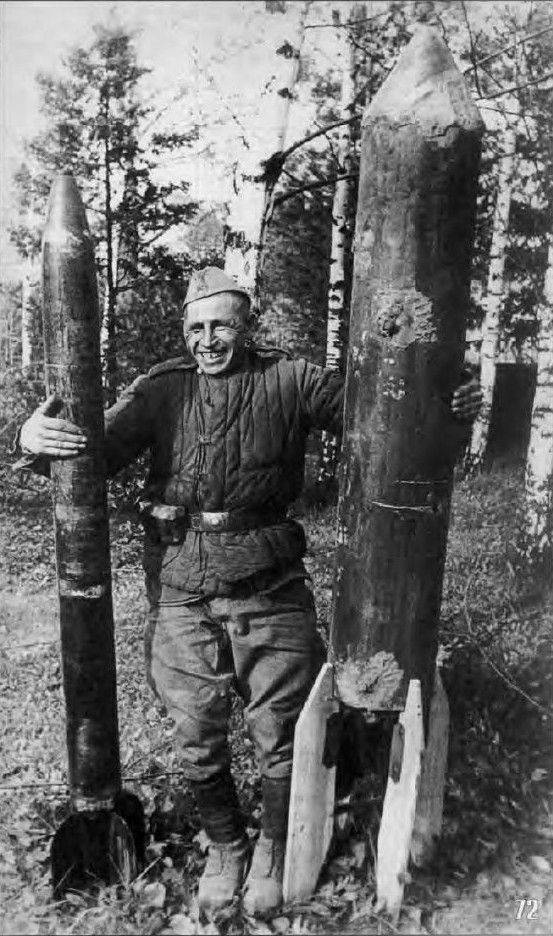
Sapper N. Kondrashev with the M-13 serial projectile (left) and the "flying torpedo" at its base. Photo: Makarov M., Kolomiets M. "Red Army Rocket Artillery, 1941-1945"
5 July 1942, the 68 th and 69 th Guards mortar regiments for the first time used the latest salvo fire system - M-30, consisting of the same projectile and launcher. Despite not too high firing range (no more than 2800 m), the new mortars proved to be a good one. In particular, they were equipped with a warhead with a charge weighing 28,9 kg, which made it possible to guaranteedly destroy manpower, equipment and enemy fortifications.
A characteristic feature of the M-30 system was a very simple launcher design, borrowed from the German project Schweres Wurfgerat. M-30 projectiles were shipped in 30 Box type closures. This product was assembled from several wooden bars and metal strips. It was assumed that the 30 Box would be used not only for transportation, but also for launching rockets. The closures should be laid and fastened on a special frame with a vertical pick-up device and electric igniters. This is a simple product and was the launcher type M-30.
At the end of 1942, M-31 projectiles with increased characteristics began to be sent to the troops. Like the M-30, they were supplied in wooden stoppers with metal guides to run. Due to the similar dimensions and weight, the boxes for M-31 are fully compatible with the M-30 launcher. Nevertheless, in the spring of 1943, the release of a reinforced version of this installation was launched with the possibility of launching eight shells in one salvo.
Initially, M-30 and M-31 projectiles were used only with M-30 launchers. Nevertheless, at the final stage of the Great Patriotic War a new method of their application appeared. In the context of urban battles, gunners did not always have the opportunity to bring self-propelled mortar to the right street, not to mention the deployment of the M-30 launcher. This was hampered by enemy fire, the lack of necessary space and other factors. In addition, often a volley of four or eight shells could be excessive to hit an existing target.
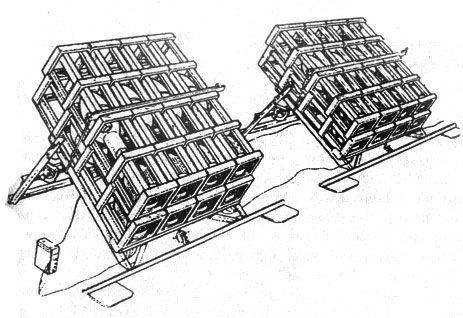
Installing M-30 with M-30 projectiles. Figure Epizodsspace.no-ip.org
Thus, by the winter of the 1945 of the year (according to some data, earlier), there was a proposal to use the available missiles without special launchers. In this case, one “30 Box” or other similar product could be installed in a building window, wall breaks or other “embrasures”, point at the target and launch.
This technique was used most actively during the battles for Koenigsberg. Separate groups of rocket projectiles were formed especially for the firing of point targets in the Guards mortar brigades. Each brigade usually had no more than two or three such units. They consisted of 10-12 people, among whom were the commander, gunner, electrical engineer, etc.
Having been instructed by the commander, the group was to be advanced to its future firing position, having several M-31 projectiles with it in closures. Upon arrival, the fighters were looking for a suitable window or a hole in the wall, in which the cork with the projectile was mounted. In order to avoid improper flight of the projectile to the target box was fixed in the desired position. At the same time made a tip horizontally and vertically. After that, it was possible to connect the electric ignition system and start. As a power source, PM-2 blasting machines or types of batteries were commonly used.
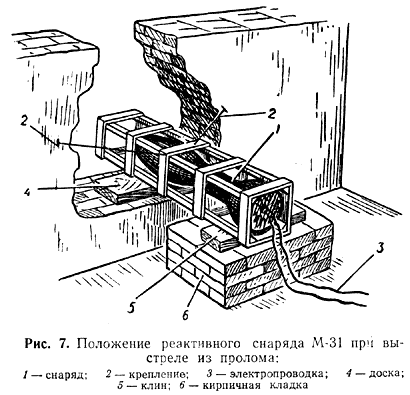
Launch M-31 projectile through the breach in the wall. Figure Kolomiets G.A. "Actions of artillery units in the Great Patriotic War. 13 collection. Artillery units and units in battles for large settlements"
It is easy to see that a short wooden box-capping cannot serve as a full-fledged starting guide, which provides high accuracy of shooting. In addition, for the effective destruction of the building, the projectile had to fall into the wall after the engine had fully developed fuel and had completed the active part of the flight. In this case, the projectile had the highest possible speed and penetrating action. Thus, in most cases, the firing range ranged from 50 to 200 m. Due to the small distance to the target, certain measures had to be taken. For example, groups of missiles were assigned escorts from 10-12 machine gunners. Usually these were soldiers of the same division as the group itself.
The main objective of the groups of rockets was the houses and buildings that served as strongholds of the enemy’s defenses. Unable to advance further, the commander of the infantry unit could request the support of the artillerymen. In this case, the group was promoted to the firing position and made one or more M-31 projectile launches. Given the characteristics of this product, it is easy to imagine what were the results of the shelling. In most cases, the result of the shelling depended only on accuracy. A projectile hit with an 28,9-kg warhead capable of breaking through a stone wall was guaranteed to destroy walls and floors. If necessary, it was possible to make another shot, which completed the destruction of the target and the destruction of the garrison of the strong point.
Shooting missiles from windows, doors and holes in the walls quickly showed its effectiveness. Despite some risk, the gunners quickly destroyed the specified target, providing a further breakthrough of the enemy defenses. In the course of the Königsberg operation, a group of missiles, according to various sources, conducted up to several dozen launches for various purposes. All this greatly facilitated the work of the infantry, accelerated the capture of the city, and also reduced losses among personnel.
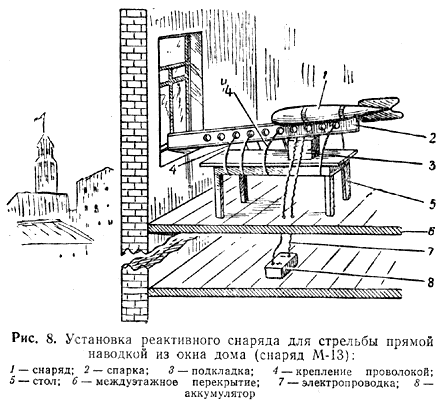
Launch M-13 projectile through the window. Figure Kolomiets G.A. "Actions of artillery units in the Great Patriotic War. 13 collection. Artillery units and units in battles for large settlements"
In the future, the Red Army again used a similar method of using rockets, and it received some development. By the time the Red Army approached Berlin, groups of missiles had managed to make war in several large cities. During this time, they worked out a new technique, and also expanded the range of their weapons. It is known that in the battles for Berlin not only M-31 was used, but also other projectiles, such as M-20 or M-13, in the basic and modified versions.
The use of single rocket launches in Berlin is described in detail in the brochure “Actions of artillery units in the Great Patriotic War. 13 Collection. Artillery units and subunits in the battles for large populated areas ”, authored by Colonel G.A. Kolomiets. It should be noted, the author of the book notes that with all its primitiveness, firing missiles from improvised “embrasure” with rockets had very significant results.
By the beginning of the Berlin operation, the group of missiles had time to master and test the use of several types of ammunition. In addition, some changes have undergone the structure of such units. Now the attack targets were so-called. assault groups of guards mortar units. They included a commander, electrical engineer and several other specialists. When the group was armed with heavy M-31 shells, its number reached 25 people. The assault team with M-13 consisted of 8-10 people.
The assault groups of rocket artillery were attached to rifle battalions or regiments. The tasks for her were set by the commander of the combined-arms assault group. Such a structure made it possible to properly coordinate the actions of infantry and artillerymen, suppressing the enemy’s firing points in time.
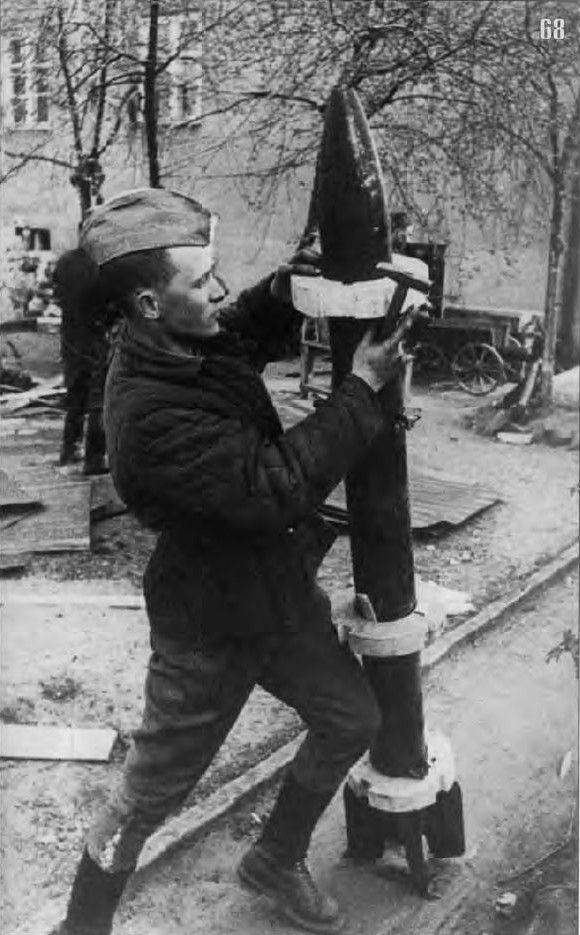
Installation of support rings for additional housing. Photo: Makarov M., Kolomiets M. "Red Army Rocket Artillery, 1941-1945"
As before, during combat operations, the assault groups reached the improvised firing positions at a range of about 50-200 m from the assigned target. They made the installation of the launcher (box-capper), preparing the system for firing, aiming and shot. Colonel Kolomiets notes that when firing at a target located below the firing position at a distance of up to 100 m, the boxes were laid horizontally on the window sill. At a target that was at the same level or higher than the position of the artillerymen, as well as at a greater distance, they were shot from a certain angle of elevation.
The horizontal targeting of the launcher was carried out by turning it before fastening in its place. Usually, the front part of the capping or guide was fixed on the windowsill, and under the back some object of sufficient dimensions was placed, with the help of which the correct position of the launcher was ensured. Then all flammable objects were removed from the room, after which it was possible to make a shot.
Sometimes shooting from buildings was impossible. In such cases, projectiles were launched from existing open areas, such as streets or courtyards. At the same time, however, it was necessary to increase the firing range to 400-600 m, which made it possible to reduce the risks for gunners, but it affected the effectiveness of firing due to the possible slowdown of the projectile in the final flight segment.
By the beginning of the battles for Berlin in the arsenal of assault groups, new launchers appeared, similar to M-30, but differing in size. They placed only two boxes with M-31 projectiles, which made it possible to provide acceptable firepower, but did not lead to a significant increase in the weight of the structure. The M-20 and M-13 projectiles were launched from guides made from units of the BM-13 combat vehicle.
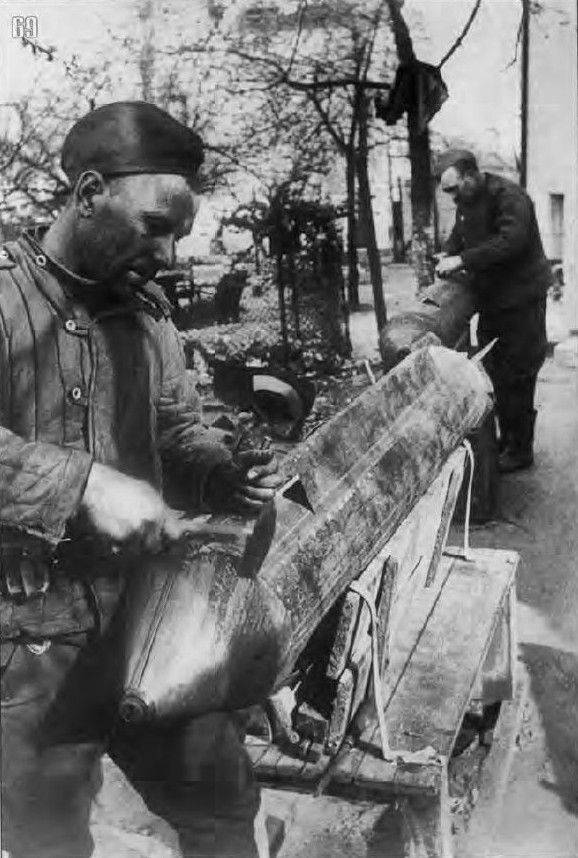
The formation of the head fairing. Photo: Makarov M., Kolomiets M. "Red Army Rocket Artillery, 1941-1945"
The upgraded version of the M-13 missile was mentioned above. This product should be discussed in more detail. The BM-13 rocket launcher inflicted serious damage to the enemy’s targets due to the launching of several projectiles. The amount of ammunition compensated for a relatively small weight of the charge of the warhead - 4,9 kg. When shooting at buildings, the power of such a warhead could not always lead to the desired results. Because of this, specialists thought about the modernization of the shells, which could be carried out in the conditions of military workshops.
The transformation of the standard M-13 into a land “flying torpedo” began with the installation of several split wooden rings on its body. Then an additional cylindrical case was fixed on them, the diameter of which was slightly smaller than the diameter of the stabilizers. The head part of the body was bent in the form of a conical fairing, and in the tail section several new large stabilizers were mounted. After that, melted TNT was poured through the holes in the body. As a result of this modernization, the charge of the projectile increased several times, sharply increasing its power.
Using rocket projectiles of several types, including handicraft upgrades, assault groups successfully accomplished the task of destroying various enemy targets. For obvious reasons, heavier shells with a greater weight of the warhead had the highest efficiency. In the book “Actions of artillery units in the Great Patriotic War. 13 Collection. Artillery units and units in battles for large populated areas ”provide several examples of the use of such weapons.
During the battles for Berlin, the artillerymen received an order to destroy the house at the corner of Lindenstrasse and Komendantenstrasse, which was the stronghold of the enemy. The assault group of missiles deployed their weapons in the building at a distance of about 150 m from the target. Three M-31 shells were placed in the windows of the second floor. In this case, the shells were to hit the wall of the target building at an angle of the order of 40-45 °. The thickness of the walls reached half a meter. The assault team aimed projectiles between the second and third floors, i.e. on the alleged location of the enemy fighters.
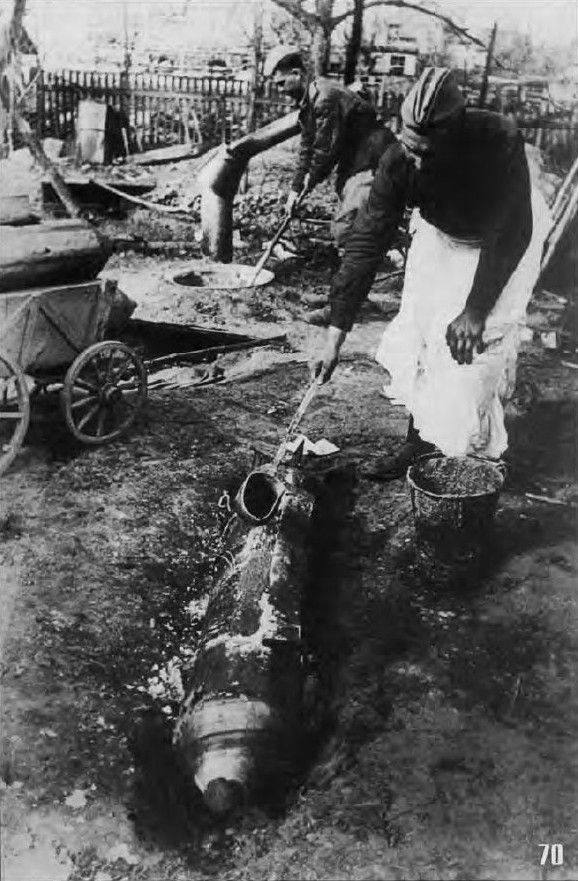
The process of pouring molten TNT into the body of a "flying torpedo". Photo: Makarov M., Kolomiets M. "Red Army Rocket Artillery, 1941-1945"
Despite the high angle of the meeting and the thick walls, all three shells pierced the barrier and got inside the building. One munition broke through the wall at the level of the third floor, the other two hit the second. Undermining of the combat units occurred after breaking through the walls. With the explosion collapsed facade of the building and interfloor overlap. Several internal walls were also destroyed. The garrison of the stronghold ceased to exist. After that, the Red Army easily occupied the building.
Not being able to shoot from the required distance, the assault groups could not fully solve the task. Thus, during the storming of a building in the Niderwalshtrasse district, the gunners fired direct fire from the entire 30 m. One projectile hit the fourth floor wall (the wall thickness was 55 cm) and knocked out part of the corner stack. The second shell hit the ground floor and caused significant damage to the wall, but could not destroy it completely. During the 30 of flight, the projectile did not manage to reach the maximum speed, due to which its kinetic energy was insufficient to break through the wall and cause the enemy the maximum possible damage.
During the battle for Berlin, the assault artillery groups were damaged or destroyed 120 various buildings. At the same time, several dozen gun firing points were suppressed or destroyed, 3 mm caliber guns were destroyed, and more than a thousand enemy soldiers and officers were killed.
The method of using rockets in urban battles was not very complex and did not require special equipment. Nevertheless, M-31, M-20 and M-13 shells of all versions caused great damage to the enemy, and also facilitated the advancement of Soviet troops. With the help of rocket projectiles equipped with powerful high-explosive fragmentation warheads, it was possible to level the advantages of the enemy associated with the peculiarities of the urban landscape. The enemy tried to arrange strong points and firing points in existing buildings, which gave him some tactical advantages. Missiles with relatively simple launchers, in turn, made it possible to destroy similar enemy targets and facilitate the advancement of their troops. Thus, despite the simplicity or even primitiveness, the original proposal of the gunners proved to be very useful and helped bring victory over the enemy closer.
Based on:
http://rbase.new-factoria.ru/
http://epizodsspace.no-ip.org/
http://operation-barbarossa.narod.ru/
http://ecoross1.livejournal.com/
Kolomiets G.A. The actions of artillery units in World War II. 13 Collection. Artillery units and units in the battles for large settlements. / Management of combat training of artillery. - M .: Military Publishing, 1958
Makarov M., Kolomiets M. The Red Army Rocket Artillery, 1941-1945 // Front Illustration - 2005 - №3
Information